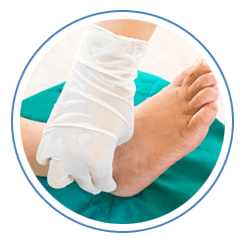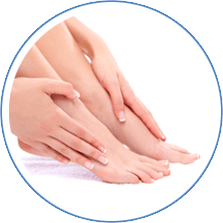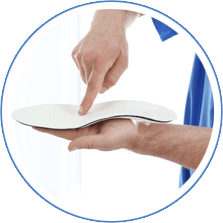At North Dallas Podiatrist, we provide comprehensive care for all your foot and ankle needs. Our experienced podiatrists are dedicated to helping you maintain your health and mobility through the highest quality of foot care. With state-of-the-art technology, advanced treatment options, and a compassionate, caring approach, we strive to be your trusted partner in achieving and maintaining a healthy lifestyle.

Podiatrist Dallas
At North Dallas Podiatrist, we offer a wide range of services tailored to your unique needs. We specialize in diagnosing and treating conditions affecting the feet and ankles, such as heel pain, arch pain, ingrown toenails, plantar warts, bunions, flat feet, neuropathy, and much more. Our team also provides preventative care, orthotics, ultrasound imaging, and nonsurgical treatments to ensure that you receive the best possible care from our team of dedicated professionals.
Common Foot Problems
At North Dallas Podiatrist, we understand that foot and ankle issues can be a source of discomfort and concern for our patients. This page is dedicated to providing information on some of the most common foot problems. We believe that well-informed patients are able to make more informed decisions about their care. Common Foot Problems that our Podiatrist in Dallas can treat:
Plantar Fasciitis
Plantar fasciitis is one of the most common causes of heel pain. It involves inflammation of a band of tissue that runs along the bottom of the foot, connecting your heel bone to your toes. Symptoms include heel pain when walking or standing and may even feel worse in the morning or after prolonged periods of rest. Treatment options are available to reduce symptoms and include rest, physical therapy, and custom orthotics.
Achilles Tendinitis
The Achilles tendon is the largest tendon in your body and connects your calf muscles to your heel bone. Inflammation or irritation of this tendon can cause pain, stiffness, and difficulty walking. It is important to consult a podiatrist if you experience any symptoms of Achilles tendinitis as early diagnosis and treatment are important for avoiding further complications. Treatment options typically involve rest, stretching exercises, ice therapy, and medications.
Bunions
Bunions are bony bump that forms along the outside edge of your big toe joint, causing your big toe to angle toward your other toes. While bunions can be uncomfortable, they aren’t necessarily painful. However, if left untreated, bunions can become worse. Treatment options typically involve wearing wider shoes, changing shoe styles, using orthotics, or in severe cases, surgery.
Morton’s Neuroma
Morton’s neuroma is a nerve condition in which a lump forms on the bottom of your foot between two of your toes. It is caused by compression of the nerve and can result in numbness, tingling, burning pain, or stabbing sensations between the affected toes. Treatment options are available to alleviate symptoms including custom orthotics, steroid injections, physical therapy, and in extreme cases, surgery.

Advanced Technology
At North Dallas Podiatrist, we use the most advanced and up-to-date technology available in order to provide accurate diagnoses and efficient treatments. From digital X-rays and 3D CT scans to custom orthotics and laser therapy, we have the resources necessary to provide you with the best possible care.
Compassionate Care
At North Dallas Podiatrist, patient satisfaction is our top priority. We understand how frustrating it can be when you’re dealing with a foot or ankle problem, so we make sure to take the time to listen to your concerns and answer any questions you may have. Our team is committed to providing excellent care in a warm and welcoming environment.
When to see a podiatrist?
Foot health is crucial to maintaining your overall well-being. While you may be tempted to ignore foot pain or discomfort, it’s important to take care of your feet and address any issues as soon as possible. Podiatrists are medical professionals who specialize in diagnosing and treating conditions of the feet and ankles. If you’re experiencing any of the following symptoms, it’s time to make an appointment with a podiatrist:
- Persistent pain in your feet or ankles
- Numbness or tingling in your feet
- Swelling or redness in your feet or ankles
- Difficulty walking or standing without pain
- Sores or wounds that won’t heal on your feet
- Ingrown toenails or toenail fungus
- Corns, calluses, or blisters on your feet
- A foot or ankle injury that isn’t healing properly
These are just a few of the many reasons why you may need to see a podiatrist. Your podiatrist can perform a thorough examination, diagnose the problem, and develop a treatment plan that’s tailored to your specific needs. Don’t wait until your foot problems become more severe – schedule an appointment with a podiatrist today to keep your feet healthy and pain-free.
What to expect during a podiatry appointment
If you have never visited a podiatrist before, you may be wondering what to expect during your first appointment. The podiatrist will start by asking you about your medical history, any medications you are taking, and any symptoms you are experiencing, such as pain, swelling, or difficulty walking. They will then conduct a thorough examination of your feet, checking for any issues such as calluses, corns, or ingrown toenails. They may also use imaging tests such as X-rays to get a better look at the bones in your feet.
Based on their findings, the podiatrist will then recommend a treatment plan tailored to your specific needs. This may include medication, physical therapy, or custom orthotics to help correct any issues with your feet. The podiatrist will also provide you with advice on how to care for your feet, including recommendations for footwear, exercises to improve foot strength and flexibility, and tips for preventing foot problems in the future.
It’s important to note that podiatrists are specialists in foot and ankle care, and they are highly trained to diagnose and treat a wide range of foot conditions. By seeking treatment from a podiatrist, you can be confident that you are getting the best possible care for your feet.
Podiatry treatments explained
Podiatry treatments are an essential component of maintaining healthy and pain-free feet. Podiatrists are trained professionals who specialize in diagnosing, treating, and preventing foot and ankle problems. They offer a range of treatments that are specifically tailored to the needs of each patient, depending on their individual circumstances.
 One of the most common podiatry treatments is orthotics, which are custom-made shoe inserts that help to correct foot abnormalities and improve overall foot function. Podiatrists may also prescribe medications to treat foot infections or other conditions or recommend physical therapy to help strengthen and stretch the muscles and joints in the feet.
One of the most common podiatry treatments is orthotics, which are custom-made shoe inserts that help to correct foot abnormalities and improve overall foot function. Podiatrists may also prescribe medications to treat foot infections or other conditions or recommend physical therapy to help strengthen and stretch the muscles and joints in the feet.
In more severe cases, podiatric surgery may be necessary to correct structural abnormalities or address chronic pain issues. These procedures are typically performed on an outpatient basis, and recovery times can vary depending on the specific procedure and the patient’s individual needs.
Regardless of the type of treatment required, it’s important to seek out the services of a qualified and experienced podiatrist to ensure the best possible outcomes. By working closely with a podiatrist, patients can get the care they need to maintain healthy and pain-free feet for years to come.
Orthotics: What are they and how do they work?
Orthotics are custom-made shoe inserts that are designed to correct any irregularities in your feet, such as flat feet, high arches, or any other foot condition that may cause discomfort or pain. Orthotics can be made from a variety of materials including foam, rubber, or plastic, and are designed to provide arch support, cushioning, or stability to your feet.
 The process of getting orthotics begins with a consultation with a podiatrist who will examine your feet, assess your gait, and analyze any pain or discomfort you may be experiencing. Based on this assessment, your podiatrist will design a custom orthotic that is tailored to your individual needs.
The process of getting orthotics begins with a consultation with a podiatrist who will examine your feet, assess your gait, and analyze any pain or discomfort you may be experiencing. Based on this assessment, your podiatrist will design a custom orthotic that is tailored to your individual needs.
The benefits of using orthotics are numerous. They can help to alleviate pain in your feet, legs, hips, or back by providing support and cushioning to your feet. They can also improve your balance, posture, and mobility, by helping to correct any biomechanical issues in your feet.
Orthotics come in a variety of shapes and sizes, and can be designed to fit into any type of footwear, including sneakers, dress shoes, or sandals. When properly prescribed and fitted by a podiatrist, orthotics can be a highly effective treatment option for a wide range of foot conditions, from plantar fasciitis and heel spurs to shin splints and knee pain.
Preventing foot problems: Things you can do at home
Preventing foot problems is important to maintain healthy and pain-free feet. There are several things you can do at home to keep your feet in good condition. One of the most important things is to wear comfortable shoes that fit well, as ill-fitting shoes can cause pain and lead to foot problems over time. Make sure to wear shoes that have good arch support and cushioning to absorb the impact of walking and running.

Simple foot exercises: You can also maintain good foot health by doing simple foot exercises, such as stretching your toes and rolling your feet on a tennis ball. This helps to improve circulation and keep the muscles and joints in your feet strong and flexible.
Clean and Dry: Keeping your feet clean and dry is also essential in preventing foot problems. Wash your feet regularly with soap and water, and make sure to dry them thoroughly, especially between the toes. Moisture can cause fungal infections, so it’s important to keep your feet dry by wearing moisture-wicking socks and changing them regularly.
Healthy Diet: Maintaining a healthy diet and staying hydrated can also contribute to good foot health. Eating a balanced diet rich in vitamins and minerals can help to improve circulation and keep the skin and nails healthy. Drinking plenty of water also helps to keep your skin hydrated and prevent dryness and cracking.
